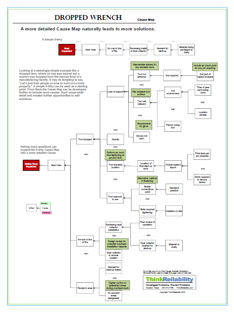Details, details, always the details!
The most frequent question I am asked during a workshop is, “How much detail should I add to my Cause Map?” While a seemingly simple question, it is quite difficult to answer simply. The concern/question usually stems from a worry that during a root cause analysis investigation we will travel down into the endless possibilities of the “rabbit hole.”Our usual approach is, “How solved do you want the problem?” but that does not give a huge amount of guidance. Let’s take a more detailed look.
Start with an outline
When doing the root cause analysis of an issue/incident, we always begin with a straightforward outline of the incident: what is the problem, what is the timing, where did it happen, and how did it impact the goals of the organization?
More detail needed for larger problems
This gives the first indicator of the level of detail needed. If there was a large impact to the goals, the problem will require a high level of detail because large incidents are a result of a large number of breakdowns. I keep in mind a quote from Diane Vaughn’s book, “The Challenger Launch Decision”, after spending a great deal of time reviewing the system of causes, and the simplified explanations for the Challenger disaster, she says, “Adding detail, improves clarity.” On a very complex incident, doing a broad brush of the causes can lead to statements like, “It was the o-rings.” Yes, the o-rings in the solid booster rockets were at issue, but to fully understand what was happening, much detail is needed to t be clear about the failure mechanism of the o-rings. By understanding the details of the failure, we put ourselves into a better position to come up with solutions that can keep the risk of recurrence at a low level.
More details leads to more solutions
The aim for the Cause Map session is to come up with possible solutions to reduce the likelihood of recurrence. A detailed map gives you more places, and specific places at that, to look for ways to prevent (reduce the risk) of the incident repeating itself.
A simple example
 If we take a look at a seemingly simple item like a dropped item, where no one was injured but a wrench was dropped from the second level of a manufacturing facility. We could be tempted to say, “Let’s just train people on how to hold on to tools properly.” The Cause Map (hypothetical) illustrates that we can use a simple 5-Why, to get a starting point. From there we can develop the map further to include more causes, and with each cause added to added definition and detail, we gain further opportunities to add solutions. To view a Cause Map of this example, click here.
If we take a look at a seemingly simple item like a dropped item, where no one was injured but a wrench was dropped from the second level of a manufacturing facility. We could be tempted to say, “Let’s just train people on how to hold on to tools properly.” The Cause Map (hypothetical) illustrates that we can use a simple 5-Why, to get a starting point. From there we can develop the map further to include more causes, and with each cause added to added definition and detail, we gain further opportunities to add solutions. To view a Cause Map of this example, click here.
It seems we always have time to react to an incident or event, but not enough time to more fully understand what happened.











